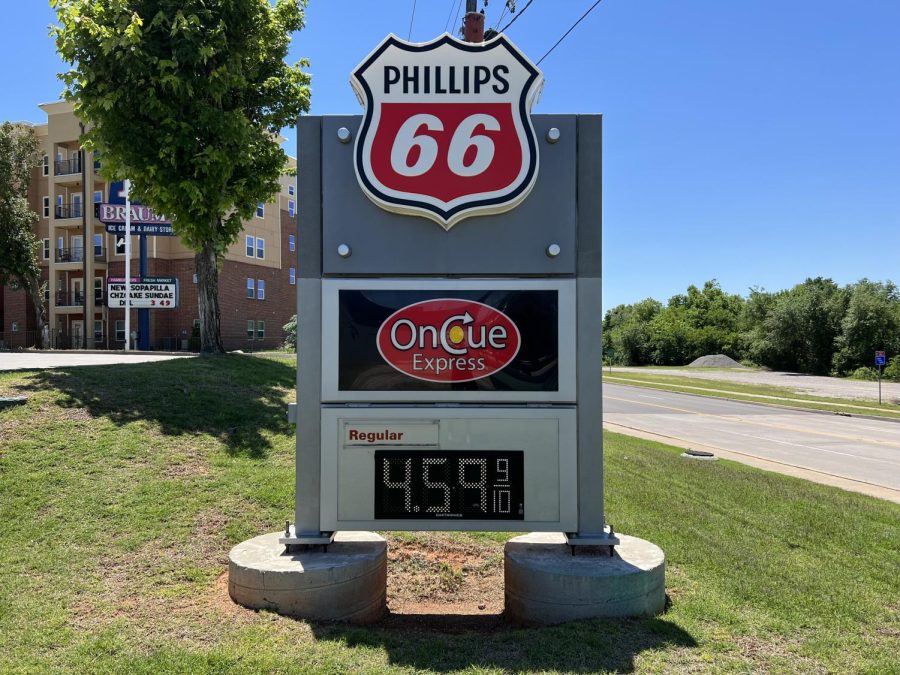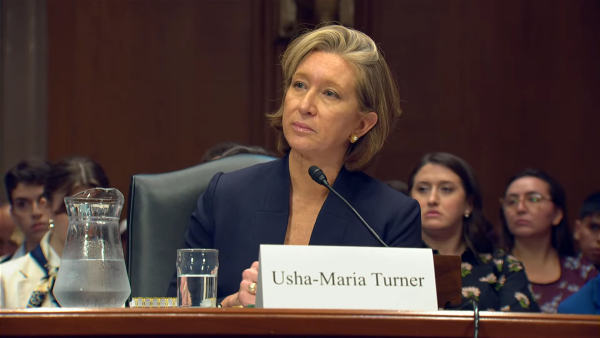Average gas prices push past $4/gallon in Oklahoma
The price of regular gas on Friday hit $4.59 per gallon at the Oncue station at East Lindsey St. and Classen Blvd. in Norman. Gaylord News Photo/Katie Hallum
WASHINGTON – As gas prices in Oklahoma soared to record highs this week, Oklahoma’s junior senator joined fellow Republican senators challenging the White House for its response to the energy crisis.
Average prices jumped above $4 for the first time in this energy-rich state. Oklahoma was one of only three states who managed to stay below $4 until last week.
Many factors have led to these skyrocketing prices, Republican senators demand a change to be made in order to pull the country out of this crisis.
At the news conference, Sen. James Lankford said the prices are affecting Oklahomans, pointing fingers at the Biden Administration for this pain at the pump.
“Having to consciously consider gas in my weekly budget again has really impacted the way I plan meals,” Jeffrey Lewis of Norman, said on Friday. “I can’t eat out near as much as I used to!”
Lewis said he is spending $40-$60 per week now for gas.
Lankford pinned the blame on Biden.
“When Oklahomans ask me why are prices up so high I can point to this,” he said pointing to a line graph headlined ‘Biden is driving up fuel prices.’
“Because the price of diesel is up, that means every single thing we buy that is transported by diesel truck all just went up in price,” said Lankford. “We are feeling the effects on every single area of the economy because President Biden is unwilling to deal with the base of our economy, that is energy, that’s energy prices.”
White House officials reportedly are considering releasing diesel fuel from federal reserves to address the skyrocketing prices.
According to AAA Gas Prices as of Friday, the average gas price in Oklahoma now sits at $4.107 compared to a year ago at $2.754. Diesel fuel is selling for an average of $5.08 per gallon. The soaring prices, which have more than doubled in the past year, has put a strain on many vulnerable Oklahoma families. Many families are having to choose between gas to get them to work, putting food on the table and paying mortgages.
“This is going to probably go down as the summer of the energy crisis. Maybe for the most vulnerable households, or households that really truly do need the assistance,” said Gregory Burge, the University of Oklahoma’s economics department chair.
“There is some sort of temporary measures that can kind of pair with those high energy prices, small tax rebates, credits for families that are low income, but have kids and we kind of know from the data that’s sort of a situation where you need to do the driving,” he said.
According to the U.S. Energy Information Administration, consumption of natural gas peaks in the summer when demand for electricity is the highest, with a smaller peak in the winter months. Gas prices reaching record highs in every state have put vulnerable families in a hard place as they transition to summer begins, being the season of highest energy consumption. This makes traveling harder while also making everyday life more stringent.
A briefing memo from the staff of the House Committee on Energy and Commerce said, “persistently high gasoline prices are a financial challenge for many Americans and disproportionately impact lower-earning Americans, who are more likely to spend a greater share of their annual income on gasoline. Nine oil companies, on the other hand, are making significant profits, with the six companies testifying at this hearing collectively generating more than $76 billion in profit in 2021.”
According to the Energy Information Agency, the price of gas is affected by many factors, the leading one being the price of crude oil, consisting of 61% of the cost of one gallon. The price of crude oil is affected by several factors, including global production levels, inventory balances, demand trends, and geopolitical events, such as Russia’s invasion of Ukraine.
The remaining factors affecting the price are the costs of refinement (14%), distribution and marketing (11%), and taxes (14%).
“While we are seeing prices level off, uncertainty still continues which creates volatility and I don’t believe we are out of the woods yet,” said Rick Muncrief, CEO of Devon Energy in a hearing with the Energy and Commerce Committee on April 6. “Shifting our operations, Devon operates on private, state, federal and Indian leases and must follow numerous stringent permitting processes before we can begin production.”
Muncrief offered no further comments following the hearing despite the record-breaking prices.
Efforts to tame the surge in energy prices have had little impact. In March, President Biden announced he would begin releasing 1 million barrels of oil per day for the next six months from the Strategic Petroleum Reserve, in an effort to bring down gas prices.
“One of the things I’m starting to get a little bit worried about is for the first six or seven weeks of the Russian invasion people were talking about, we’ll just release some of our strategic oil reserves,” said Burge. “We have strategic petroleum reserves in our country and heading into the summer they were at pretty historically average levels. Now they’re at unprecedentedly low levels. ”
With no end in sight to this energy crisis, Lankford wrote two letters to the President asking to restore America’s energy dominance. Among his fellow Republican colleagues, called on the Biden Administration to increase American oil production in order to alleviate the pain at the pump.
“I think it’s probably going a little bit overboard to say that it’s all related to steps that the Biden administration took because clearly, a big part of this is the disruption in supply chain and all this stuff going on in Ukraine and the ongoing conflict,” said Burge. “I think that the truth probably lies somewhere in the middle.”
Gaylord News reporter Katie Hallum in Norman contributed to this report.
Gaylord News is a reporting project of the University of Oklahoma Gaylord College of Journalism and Mass Communication.







